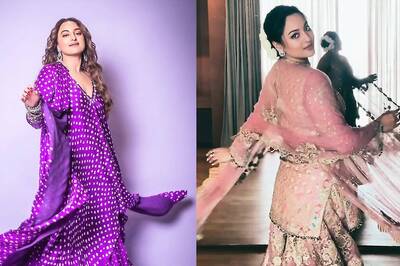
views
How to Style a Mullet
Wear your mullet as-is or spritz on a sea salt spray for a tousled look. The mullet is a true wash-and-wear style and looks best when it’s tousled and messy—meaning you can roll out of bed and wear it without any styling! If you have straight or thin hair and want to add a little bit of volume, however, use a sea salt texture spray to enhance the look of your mullet. Dampen your hair slightly and apply the sea salt spray all over your mullet. As the hair air dries, keep messing it up with your fingers to give it that tousled and beachy look. On days when your hair is misbehaving or going in wayward directions, use a bit of light-hold hairspray to lock the pieces in place.
For curly or wavy hair, style with a light-to-medium hold styling product. On damp hair, apply volumizing mousse to the roots and mid-section of your mullet. Massage a hair balm onto the ends to give some definition and create some piecey locks. Use a hair dryer with a diffuser attachment to dry your hair, and finish off the look with a light misting of flexible hairspray. If your hair is especially curly or tends to have a mind of its own, apply a light-to-medium hold gel or curl cream instead of or in addition to mousse. Depending on your hair texture, using products with a light amount of hold is essential to maintaining the mullet’s shape. Otherwise, it may fall flat or look overly messy.
Skip daily hair washing and opt for dry shampoo instead. Mullets look best when the hair is slightly dirty and oily. Wash your hair every second or third day, and use dry shampoo between washes to soak up any excess oil. A volumizing dry shampoo or texturizing dry shampoo may work particularly well to give your mullet some oomph.
28 Types of Mullets
Classic Mullet This classic vintage-style mullet features a voluminous layered top and a slightly longer back. The asymmetrical shape and contrasting lengths give off that classic rockstar look that the mullet is so well known for!
Modern Mullet The modern mullet is an updated version of the classic style, and it can be easily personalized to suit your look! A modern mullet features shorter sides along with the long back section, but it can also be curly, wavy, or modified to include fades and other trends.
Short Hair Mullet A short mullet is a more subtle version of the mullet that’s less risky and more appropriate for professional situations. The sides are closely cropped or even shaved, while the top and back of the hair are left untouched or lightly trimmed for neatness.
Medium-Length Mullet In a medium-length mullet, the hair at the back of the head falls around the nape of the neck. This style still gives off that intriguing classic mullet shape while still being a bit more classy and professional for more formal settings. The medium-length mullet is a great choice for beginners to this style, as it can easily be trimmed to a textured bob.
Long Hair Mullet A long mullet increases the length of the overall mullet—including the front pieces. The back of the mullet will fall onto or past the shoulders, and the tops and sides of the mullet are shorter but still long enough to be slicked backward—usually ending around the cheekbone. For this style, ask your barber to cut layers down to the end of your hair to keep the long section from looking limp.
Extreme Mullet An extreme mullet is a sleek and high-contrast style that really packs a punch! The sides and front of the hair are cut above the ears and eye-line, while the back section is grown out well past the shoulders. This look works best with straight hair to really emphasize the staggering contrast.
Straight Hair Mullet This mullet caters to people who already have straight and thin hair. A straight-hair mullet can be cut in almost any mullet style, but the wearer should focus on styling the front of the mullet for volume and lift. Try a volumizing mousse or sea salt texture spray.
Wavy Hair Mullet The wavy hair mullet uses the natural waves of its wearer to add texture, interest, and movement to the hairstyle. A good hairstylist will cut the mullet to accommodate the waves and create an overall effortless style. To style this type of mullet, simply brush the hair toward the back and sides for a casual and relaxed look.
Curly Hair Mullet The curly mullet is specially designed and cut for curly hair with the expertise of a professional barber or hairstylist. Curly hair complements the contrast between a mullet’s shorter and longer locks, making the look more continuous and subtle.
Shaggy Mullet Shaggy mullets are heavily layered and animated and often associated with rock or grunge styles. This choppy cut features medium to long lengths at the back of the head with slightly shorter strands up front and layers throughout. A shaggy mullet works well for any hair texture—straight, curly, or wavy. Licensed hair stylist Martin Nepton describes a shag mullet as having drastic face-framing layers, such as a bang, that gradually lengthens all the way around the back of the head. The layer on the top of the head, continues Nepton, will be about 3–6 inches (7.6–15.2 cm) long, depending on how messy you want your look to be.
Wispy Mullet This soft mullet can be cut to any length, but it must feature wispy layers that give a romantic edge to the rock-and-roll mullet style. Most importantly, the wispy mullet should include longer face-framing layers that are softly arranged at the front of the cut and provide a less extreme look to the mullet.
Feathered Mullet A feathered mullet is similar to a classic mullet but with more lightness and volume. This style works best on medium-to-longer hair, and the stylist will feather the layers of the cut to create an airy and voluminous look.
Side Mullet The side mullet is a classic mullet worn in a sideways fashion. It often features side-swept bangs or a dramatic side part. Alternatively, you can also comb the longer hair at the back of your head to one side.
Curtain Mullet Also known as the “leaf cut,” this center-parted style features curtain bangs that are swept backward in the shape of a leaf. This style is a very relaxed and casual take on the mullet, with medium-length tops and sides and a longer length in the back.
Mullet with Heavy Bangs This variation on a mullet adds choppy bangs across the forehead, balancing out the long lengths in the back. Bangs can be worn with any mullet style, including both shorter and longer cuts.
Mullet with Baby Bangs Baby bangs and mullets are a match made in heaven, as the micro-cut at the front really balances out the long locks at the back. Baby bangs can be added to a long mullet cut for an extreme look or a shorter cut for a subtle style.
Faded Mullet As its name implies, the faded mullet features “fading” along the sides of the head. The sides of the mullet fade aren’t shaved but are as short as possible without shaving. The mullet gets shorter toward the bottom of the cut, with the top being the longest part of the style.
Burst Fade Mullet In contrast to the normal fade mullet that gradually fades from long to short, burst fade mullets have a quick and dramatic transition. The style features sharp edges and lines with long locks on the top of the head.
Undercut Mullet An undercut mullet is cut high and short on the sides with a shaved look around the sides and back of the head. The longer locks around the top of the head are all one length rather than cut with a taper, as they would be in a mullet fade.
Pompadour Mullet The pompadour mullet adds a pompadour variation onto the classic mullet. This type of mullet features long lengths on the top and back of the head, but the front pieces are rolled backward from the forehead to create a pompadour. The sides are usually faded to emphasize the volume of the pompadour.
Slicked Back Mullet The slicked-back look works great for medium-length hair, putting a modern twist on the timeless classic. Use a light-hold pomade or hair balm to slick back the front pieces of the hair and blend them into the longer locks at the back.
Spiky Mullet The spiky mullet features medium-length layers but must always be styled using a firm gel, making it one of the more high-maintenance mullet styles. To style a spiky mullet, rub a firm-hold hair gel or pomade onto your hands and hair. Use your hands to shape your locks upward and into your desired spiky look.
Faux Hawk Mullet A faux hawk mullet is perfect if you want the longer hair on the top of your cut to be concentrated in the middle of your head. This mullet style features a taper fade on the sides of the head, and the longer layers are spiked up into a faux hawk using firm-hold hair gel.
Euro Mullet Popularized by football star David Beckham, the Euro mullet combines a side fade with a faux hawk. This style works particularly well on naturally textured hair, as extremely fine hair will struggle to support the weight of a faux hawk.
Bleached Mullet Pair bleached platinum hair with a mullet for an extremely bold hairstyle that would blend in with any punk or rock-and-roll group. Keep your bleached hair healthy by using hydrating hair products and applying a weekly mask for color-treated hair.
Colorful Mullet A colorful mullet freshens up the traditional style and allows the wearer to add some edge and personality to their look. Dye your entire head for a fresh new look (go for red to channel David Bowie’s “Ziggy Stardust” era), or opt for colorful ends and roots à la Billie Eilish’s neon green look.
Mullet with Beard A beard blends in well with a mullet to create a rustic yet edgy look. The bearded mullet works particularly well if your beard is thick and your hair is fine—otherwise, your style may look a bit unkempt or unfinished. Grow the mullet so that the back lengths touch the nape of your neck while the rest of the hair is kept short.
Accessorized Mullet Just because mullets can be worn as-is doesn’t mean they should be! Add a touch of personal style and polish to a mullet with a bandana, headband, claw clip, or decorated hairpins.
How to Grow a Mullet
Grow your hair out to chin-length or longer. To grow a mullet, you have to start with your hair at a decent length all the way around. Then, a barber or hairstylist can shape your hair to your desired mullet style—but this will be difficult for them to do if you haven’t taken the time to grow out your hair.
Choose the type of mullet you want. Consider how drastic you want the sides of your mullet to look and how long you want the back section to be. For a more extreme look, choose a traditional mullet with a flowing back and closely cropped slides. For something more subtle and updated, try a modern mullet with faded sides and medium-length locks. Feel free to personalize your mullet with your favorite elements from haircuts that have looked good on you in the past. For example, you might work in shorter bangs, shaggy layers, or longer perimeters to tailor the mullet to your face.
Make an appointment with a barber or hairstylist. Unless you’re skilled at cutting your own hair, you’re better off getting your mullet cut by a trained professional. Bring pictures of your preferred mullet look to ensure that your stylist knows exactly what you want your hair to look like.
What is a mullet?
A mullet is a hairstyle with short locks in the front and long strands in the back. Traditionally, the classic mullet featured an extreme contrast between the front and rear lengths—also known as the “business in the front, party in the back” style. Modern mullets, however, are less severe and more wearable for any hair type and texture. Mullets are often confused with the also-popular shag haircut. Like mullets, the shag style is highly layered, with a shorter cut in the front than in the back. The mullet, however, is more disconnected between the front of the back, while the shag is styled with a more gradual cut between the varying lengths.
When did mullets become popular?
Mullets originated in the 1970s and ‘80s but saw a comeback in 2021. The mullet debuted in the 1970s as a men’s hairstyle and became synonymous with singers like David Bowie, Paul Young, and Billy Ray Cyrus. In 2021, the mullet hairstyle started to trend again, with celebrities like Miley Cyrus, Rihanna, Maisie Williams, and Jacob Elordi all sporting the look. The 2021 version of the mullet is more subtle and also more gender-inclusive. People of all genders have adopted this trend, while the original mullet was thought of as a men’s look. The androgynous modern mullet is also often (but not always) associated with the LGBTQIA+ community, with prominent figures like Troye Sivan and Tegan & Sara wearing their hair in mullet styles.



















Comments
0 comment